Home » Posts tagged 'geodynamic evolution'
Tag Archives: geodynamic evolution
Cenozoic detrital suites from the Internal Betic-Rif Cordilleras (S Spain and N Morocco): implications for paleogeography and paleotectonics
A synthesis of Cenozoic detrital suites from the Internal Betic-Rif Cordilleras is discussed in relations with major paleotectonic phases during growth of orogenic belts. The discussion has been focused on the Malaguide and Ghomaride complexes that have a Cenozoic sedimentary detritic cover. The heterogeneous petrographic composition of coarse detrital rocks, and the mineralogy and geochemistry of mudrocks indicate a multiple source area consisting in metamorphic, and recycled siliciclastic and carbonate source rocks, with a minor supply of mafic rocks during the early Miocene. The siliciclastic coarse detrital suites plot mainly in a wide area at the Qm-Lt side in a Qm-F-Lt diagram reflecting their transition between a craton, quartzose recycled, quartzose transitional orogenic, and finally lithic transitional orogenic provenance type. The Paleocene-Eocene successions seem to be affected by higher weathering effects than the Oligo-Miocene ones. Significant recycling and reworking processes should take place during the Paleocene-Eocene and the Oligo-Miocene before the final deposition. The source areas were characterized by non-steady-state weathering conditions reflecting a progressive cooling contemporaneous to the typical evolution of source areas where active tectonism allows erosion within weathering profiles developed on source rocks. A sharp increase of siliciclastic content together with the changes in sorting-recycling-weathering suggests abrupt changes in the source area starting from Oligocene. This fact allows subdividing the succession into the lower (Paleocene-Eocene) and the upper (Oligocene-Early Miocene) cycles. Lower cycle was contemporaneous to the Eo-Alpine tectonic phase, which was reflected in the Malaguide and Ghomaride domains by basement folding and deep tectonics with fault-propagation folds, accomplished by minor rising or reliefs and deepening of subsidence areas. Contrarily, the upper cycle took place during the Neo-Alpine phase, when in the Malaguide and Ghomaride domains, thrustings should become superficial contemporaneous to subduction and stacking of tectonic units.
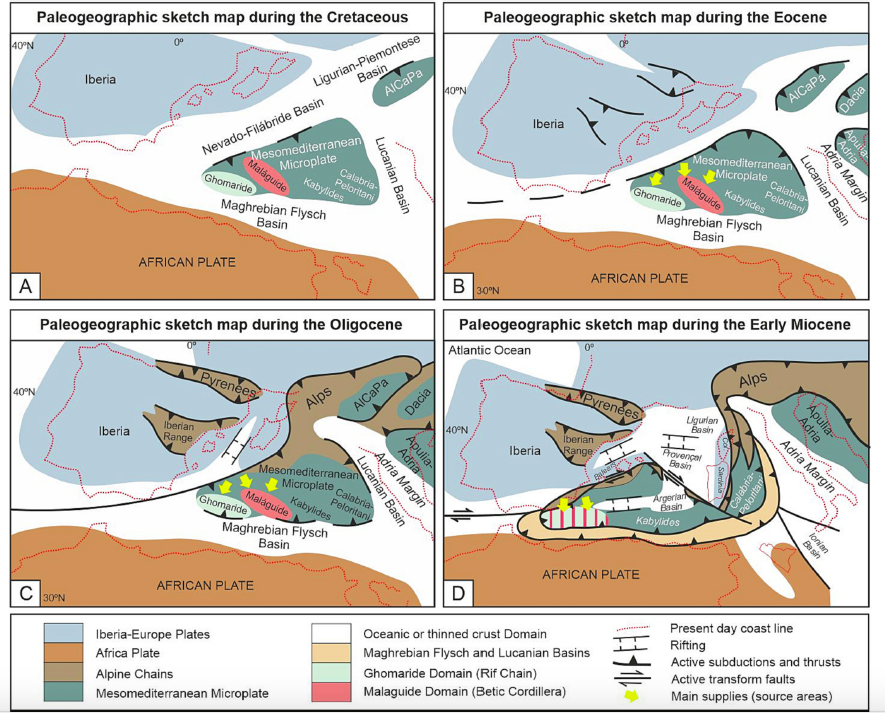
This led to a strong increasing of rising areas reflected in the sedimentation by the occurrence of coarse terrigenous deposits in wedge-top basins. The early Miocene also shows the influence of volcanism in the Mediterranean region, and/or the erosion of magmatic-metamorphic rocks derived from deep tectonic levels affected in the Eo-Alpine phase or belonging to the Hercynian bedrock. This evolution fits well with recent paleogeographic-geodynamic models for the western-central Mediterranean.
Cite as: Martín-Martín, M., Perri, F., Critelli, S., 2023. Cenozoic detrital suites from the Internal Betic-Rif Cordilleras (S Spain and N Morocco): implications for paleogeography and paleotectonics. Earth-Science Rev. 243, 104498. https://doi.org/10.1016/j.earscirev.2023.104498
Provenance and paleogeographic implications for the Cenozoic sedimentary cover of the Ghomaride Complex (Internal Rif Belt), Morocco
The Cenozoic sedimentary cover from the Ghomaride Complex (Internal Rif Belt) has been studied in the Tetuan area (N Morocco) where a suite of sedimentary successions from shallow-marine to deep-marine environments crops out. For that purpose stratigraphic relations and petrological and geochemical signatures have been analyzed. Sandstone suites of the overall succession are heterogeneous and testify a multi-source area, in response of accretionary processes of the Ghomaride-Malaguide units and the exhumation of the lower units of the Internal Rif Zone (e.g. Sebtide-Alpujarride Complex). Pre-orogenic and Syn-orogenic (according to the eoalpine phase) deposits have been identified consisting in two depositional sequences: lower Paleocene and Cuisian-Bartonian, and upper Oligocene-upper Aquitanian and lower Burdigalian, respectively. Pre-orogenic deposits are mainly intra-arenite and hybrid arenites made of a minor amount of siliciclastic detritus but with abundance of intrabasinal carbonate grains. The syn-orogenic sandstone suites are quartzolithic, having abundance of low-grade metamorphic and sedimentary lithic fragments. Sedimentary lithic fragments are derived from the Mesozoic successions of the Ghomaride-Malaguide Complex while metamorphic detritus is related to an unknow Internal Rif Zone basement that was exhumed starting from the late Oligocene and mainly early Miocene. Modal analyses of sandstone suites for the extrabasinal grains mainly indicate lower rank metamorphic and sedimentary source terranes of a recycled orogen. Major and trace elements coupled to the mineralogical composition of the mudrock samples indicate a provenance from felsic source area(s) with a minor but not negligible contribution from mafic rocks mainly in the syn-orogenic suites.
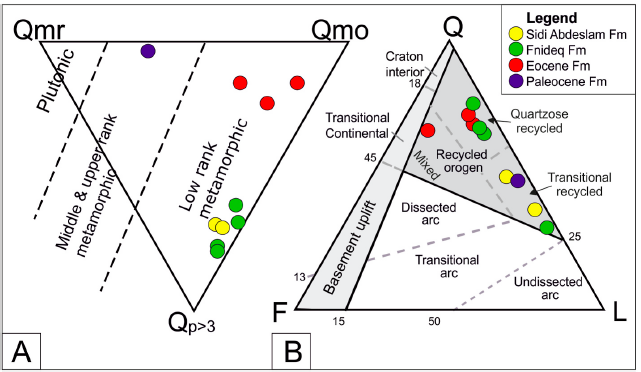
Geochemical analyses (Al–Ti–Zr ternary plot) indicate minor reworking and recycling processes before the final deposition through prolonged processes of sedimentary transportation. The trends evident in both CIA and CIA’ diagrams indicate source areas characterized by moderate weathering in non-steady-state conditions with a weak change of weathering condition from the pre-orogenic to the syn-orogenic cycle. Deposition during the Paleocene and Eocene, took place in the southern continental margin of the Ghomaride-Malaguide domain as a carbonate ramp. Contrarily, sedimentation in the late Oligocene-late Aquitanian took place in wedge-top basins within the Ghomaride- Malaguide domain. These changes occurred during the Burdigalian, when back arc basins were developed in the Internal Betic-Rif Zone. The Cenozoic reconstructed record was contemporaneous of the structuring of the Circum-Mediterranean chains and the Ghomaride-Malaguide Complex played a key role in the geodynamic evolution of the Rif Cordillera, representing a key tectonic element of the western Mesomediterranean domains.
Paleogene sedimentary evolution of the Alicante Trough
A new work to illustrate a changes in the evolution of the Alicante Trough located to the southeastern part of the sudiberian paleomargin and north to the supposed elevated sea floor forming a marine platform. Here the link to the work in Repository of the UA.
The Paleogene Alicante Trough of the South-Iberian Margin (External Betic Zone) consists of a narrow sedimentary basin that has active margins located to the north-northwest (active mainly during the Eocene) and to the south-southeast (active during the Oligocene). Both margins, consisting of shallow unstable platforms, were the source areas for the external-platform slope (in the opposite margins) and deep-basin (in the middle) depositional realms. The southern margin, lost under the Mediterranean Sea, is recognized only by the reconstructed Oligocene slope sediments.
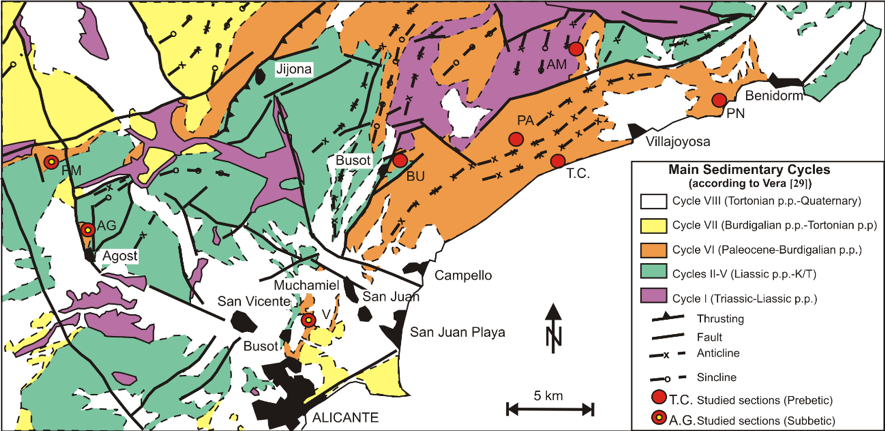
The eight successions studied, on opposites external-platform-slope margins and the deep within the central part of the basin, lead us to divide the basin into two depositional realms: the subsident Western Depositional Area (WDA) and the not subsident Eastern Depositional Area (EDA). This study has also enabled us to divide the infilling of the basin into two depositional sequences: Eocene p.p. (EDS) and Oligocene p.p. (ODS) in age, respectively, bound by two sequence boundaries (unconformities) at the Early Eocene (P6 zone) and Early Oligocene (P19 zone). The EDSand ODSare comprised of turbiditic and olisthostromic deposits and frequently slumps, evidencing an active tectonic in the margin-basin system.

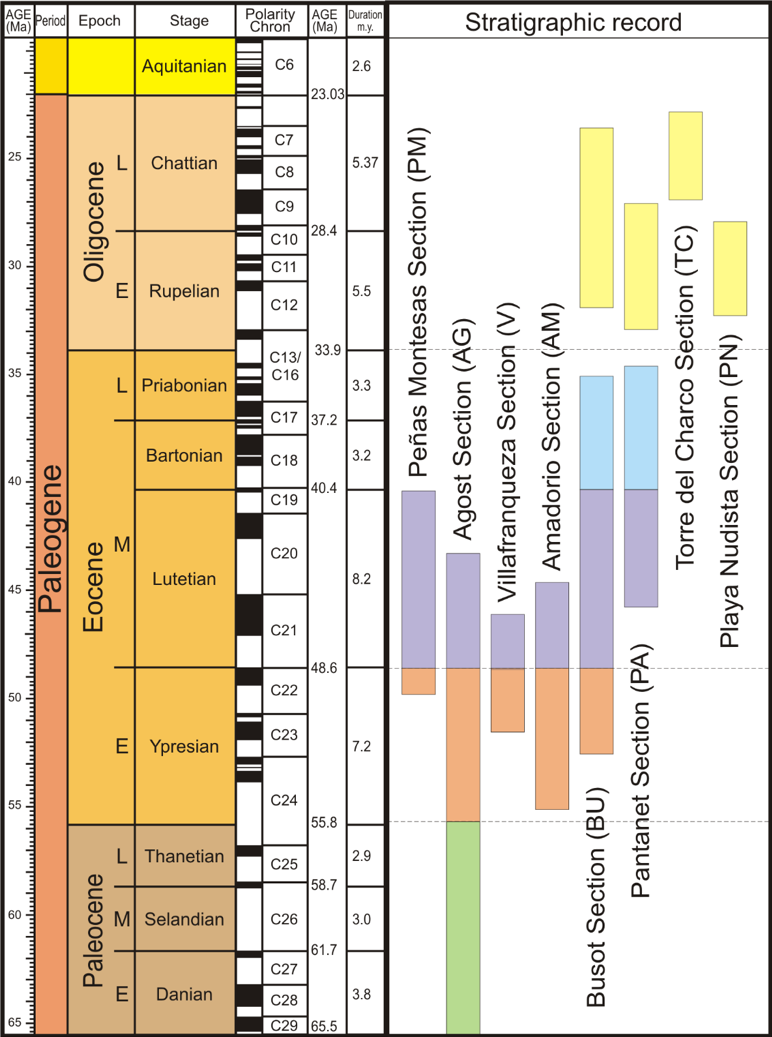
The correlation of the Paleogene sedimentary reconstructed in the Alicante Trough with other four synthetic successions throughout the External (three in the Subbetic Domain) and one in the Internal Betic Zone indicate a Paleogene generalised deformational framework.
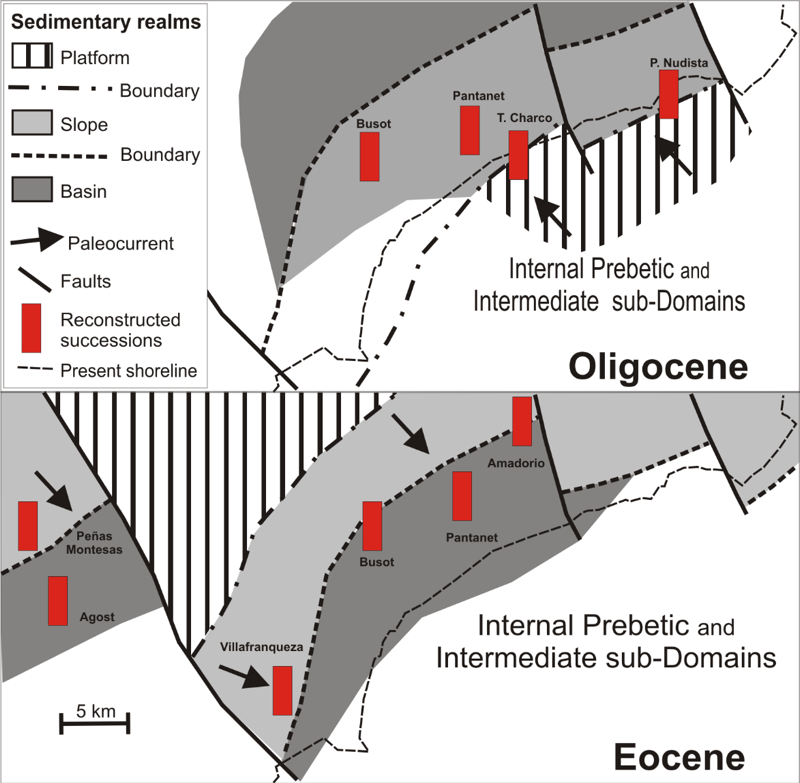
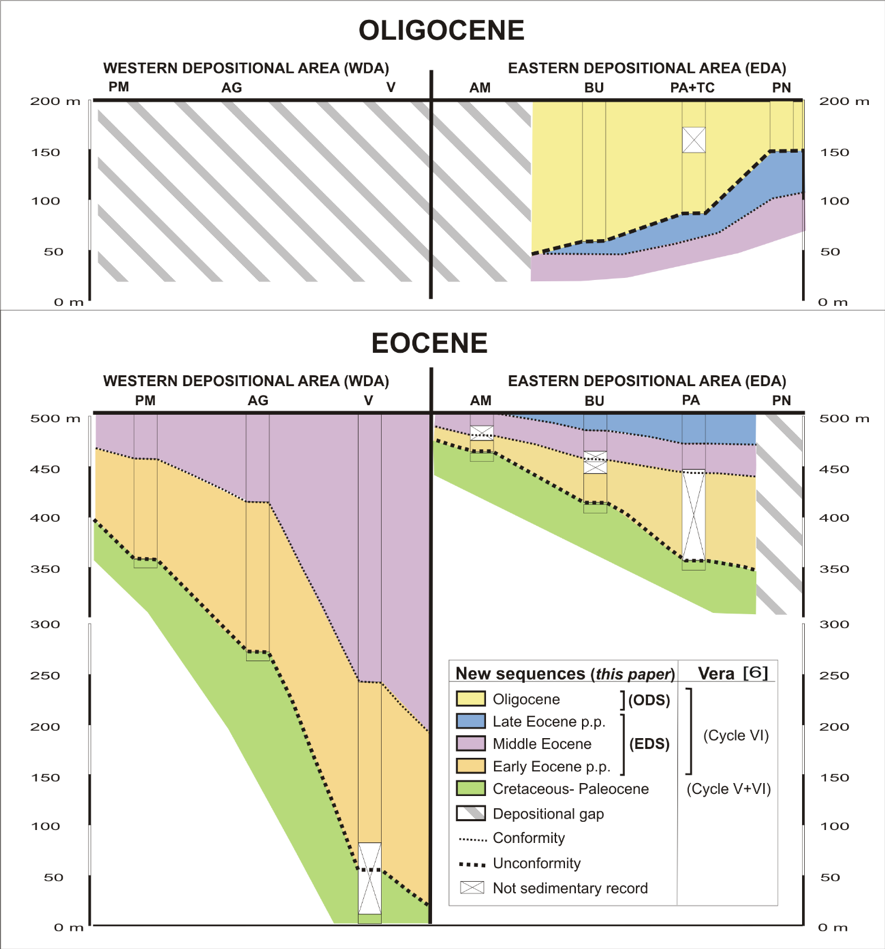
In addition, this evolution is contemporaneous to the Pyrenean, Iberian and the Nevado-Filabride Alpine deformation. The Paleogene tectonic recognised in the External Betic Zone is younger since the main orogenic deformation took place in the late Burdigalian to early Tortonian.
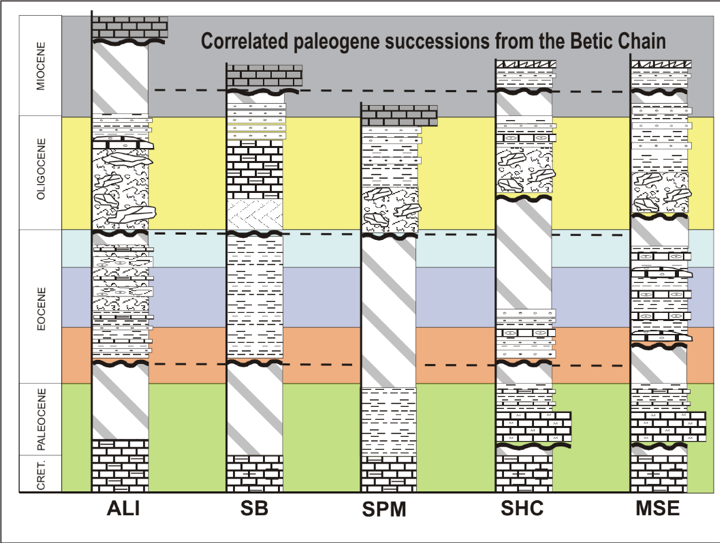
The origin of these early tectonics is discussed in relation to the Nevado-Filabride Alpine deformation.
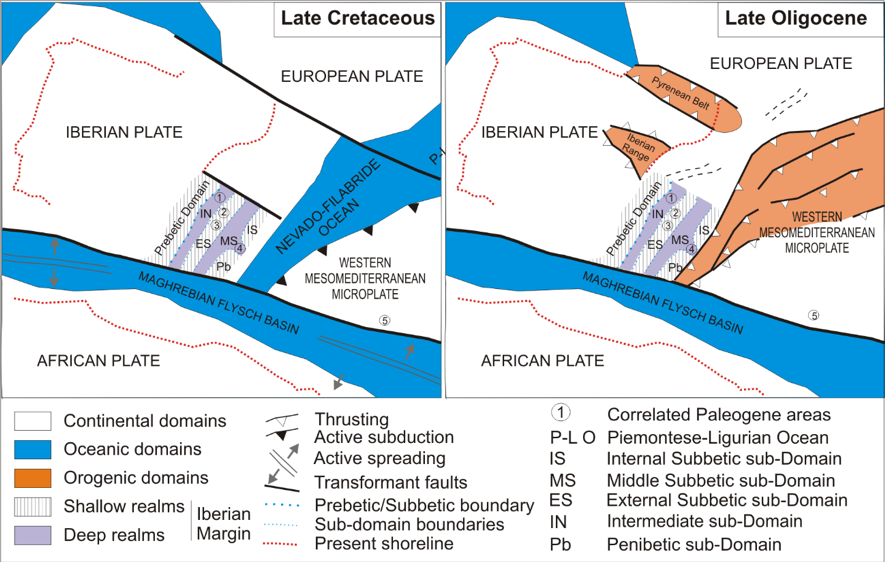
Recent Comments